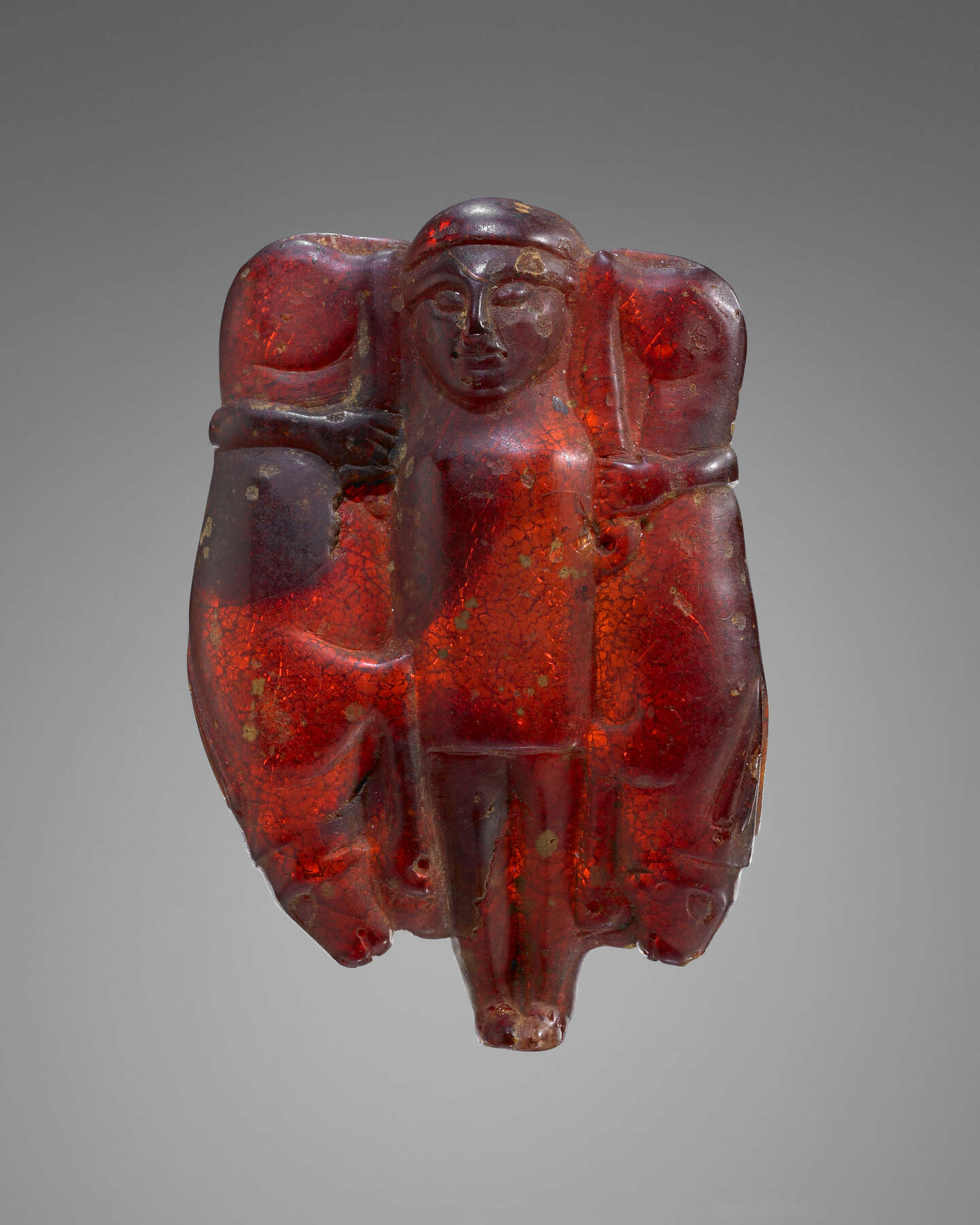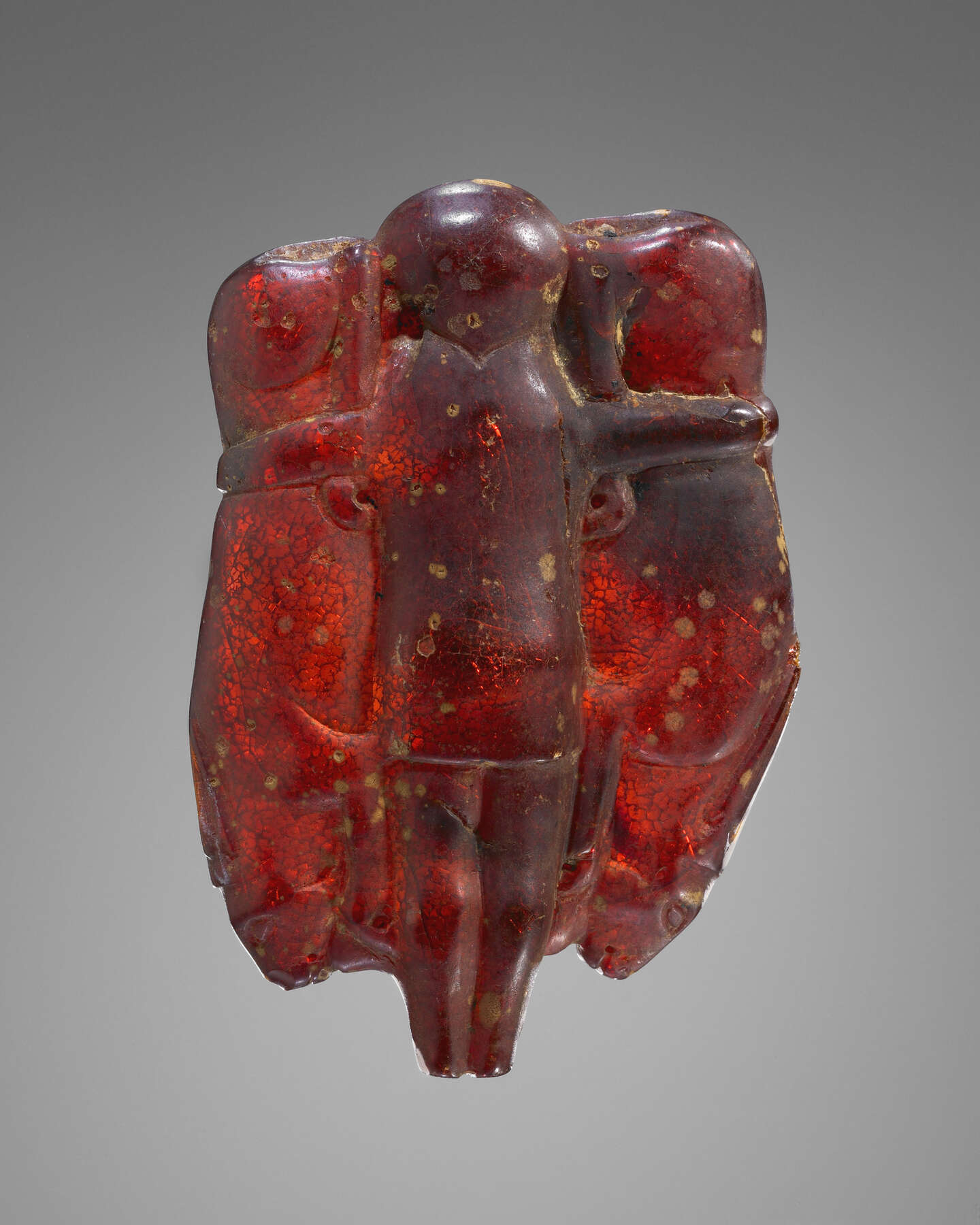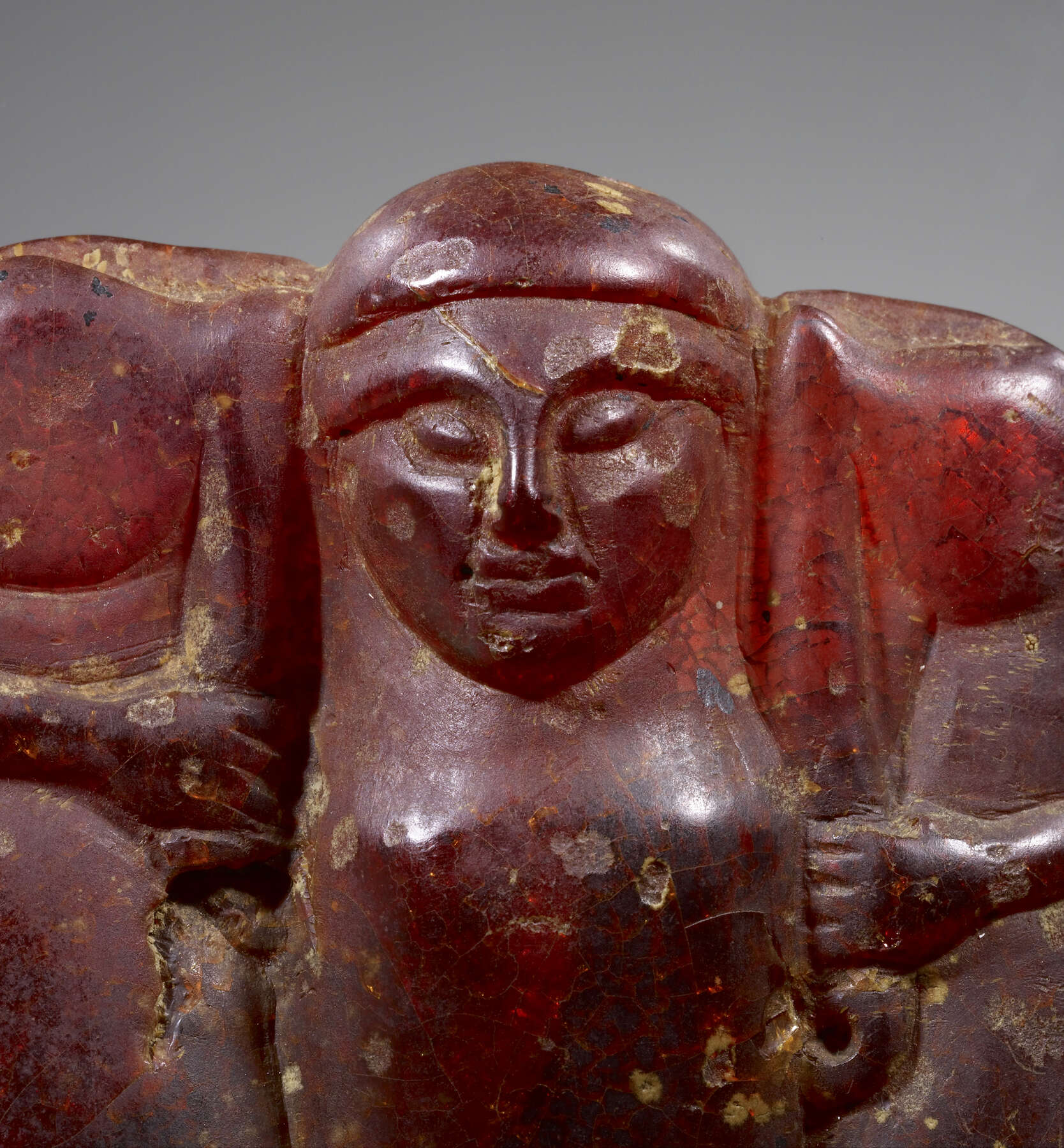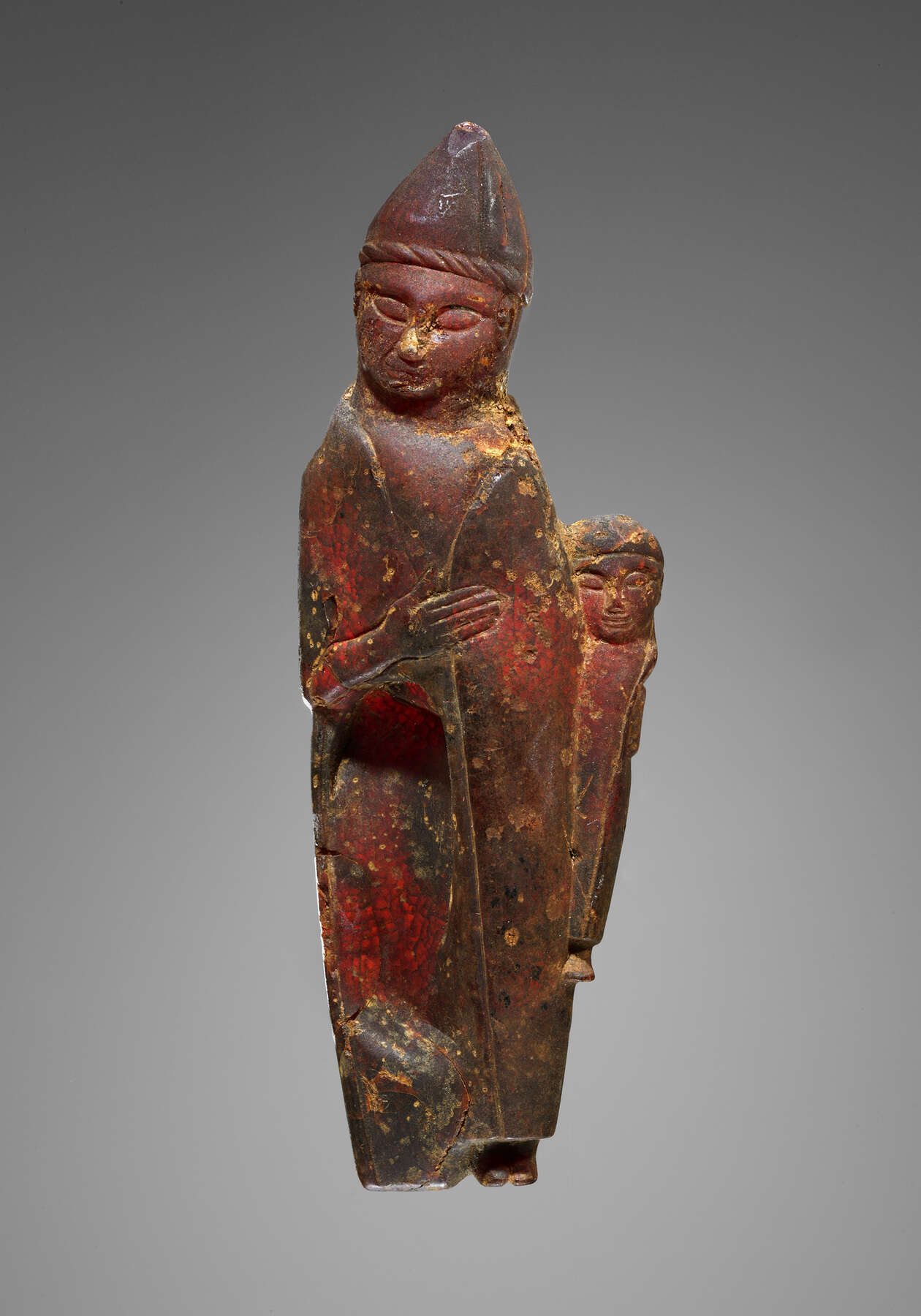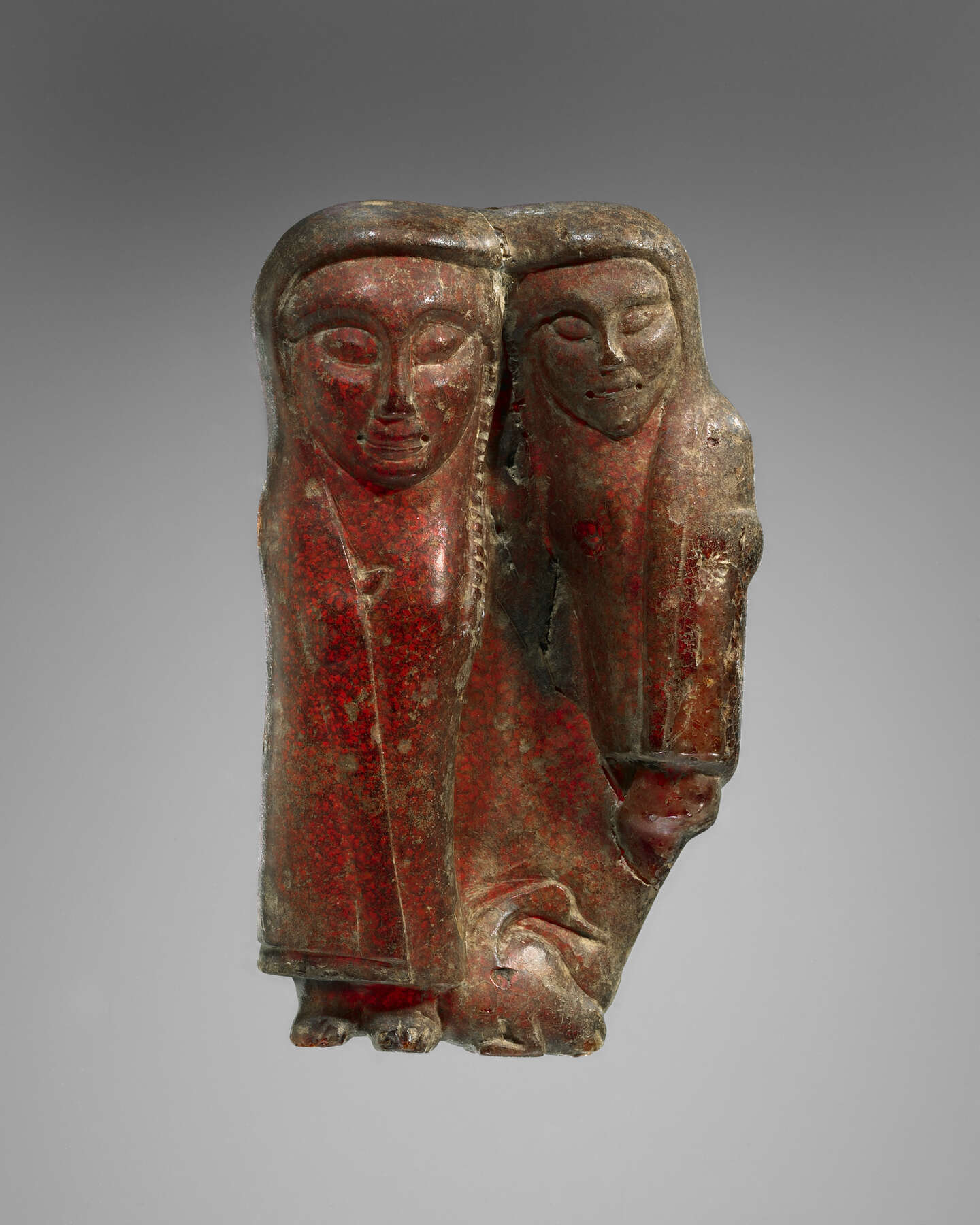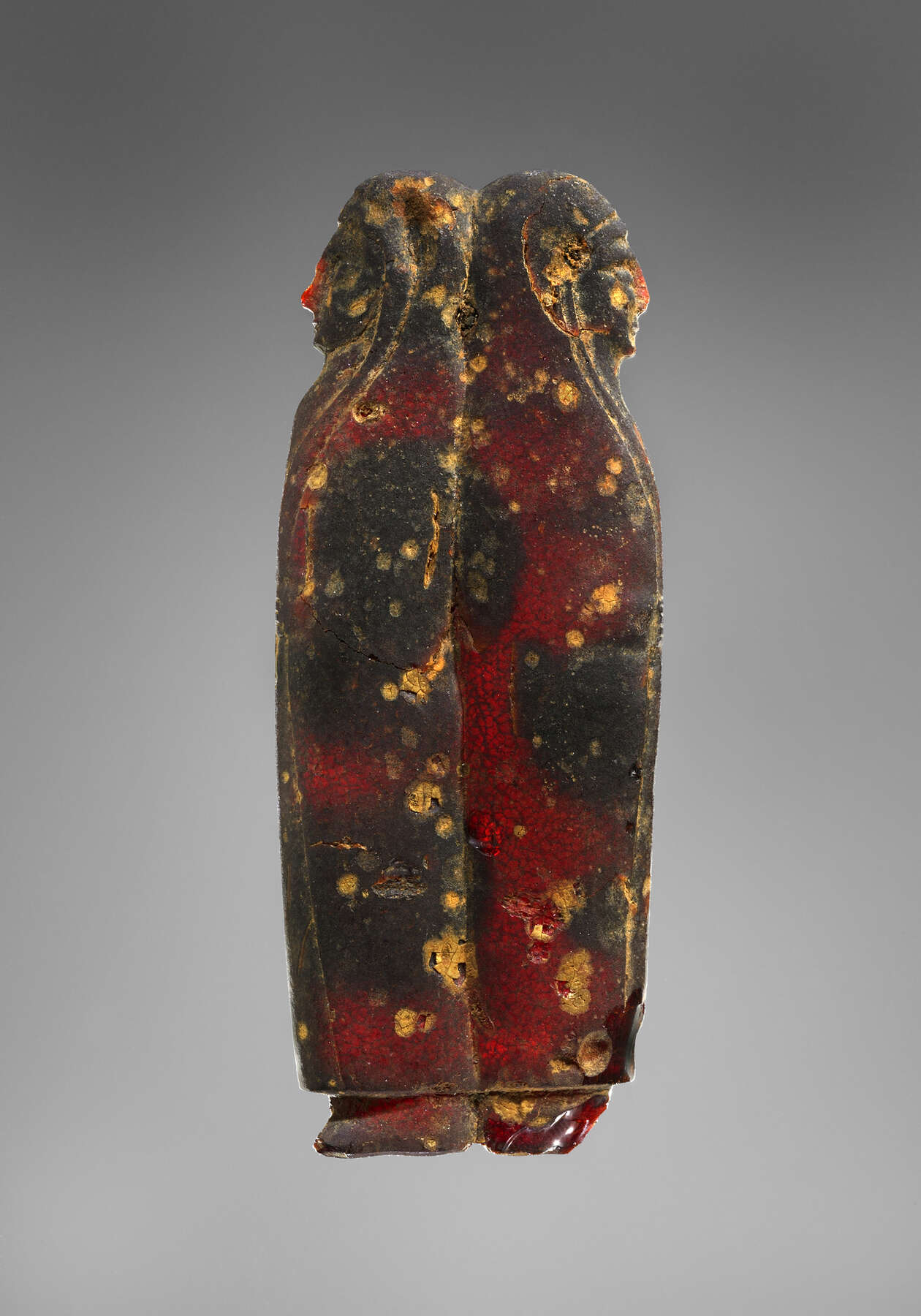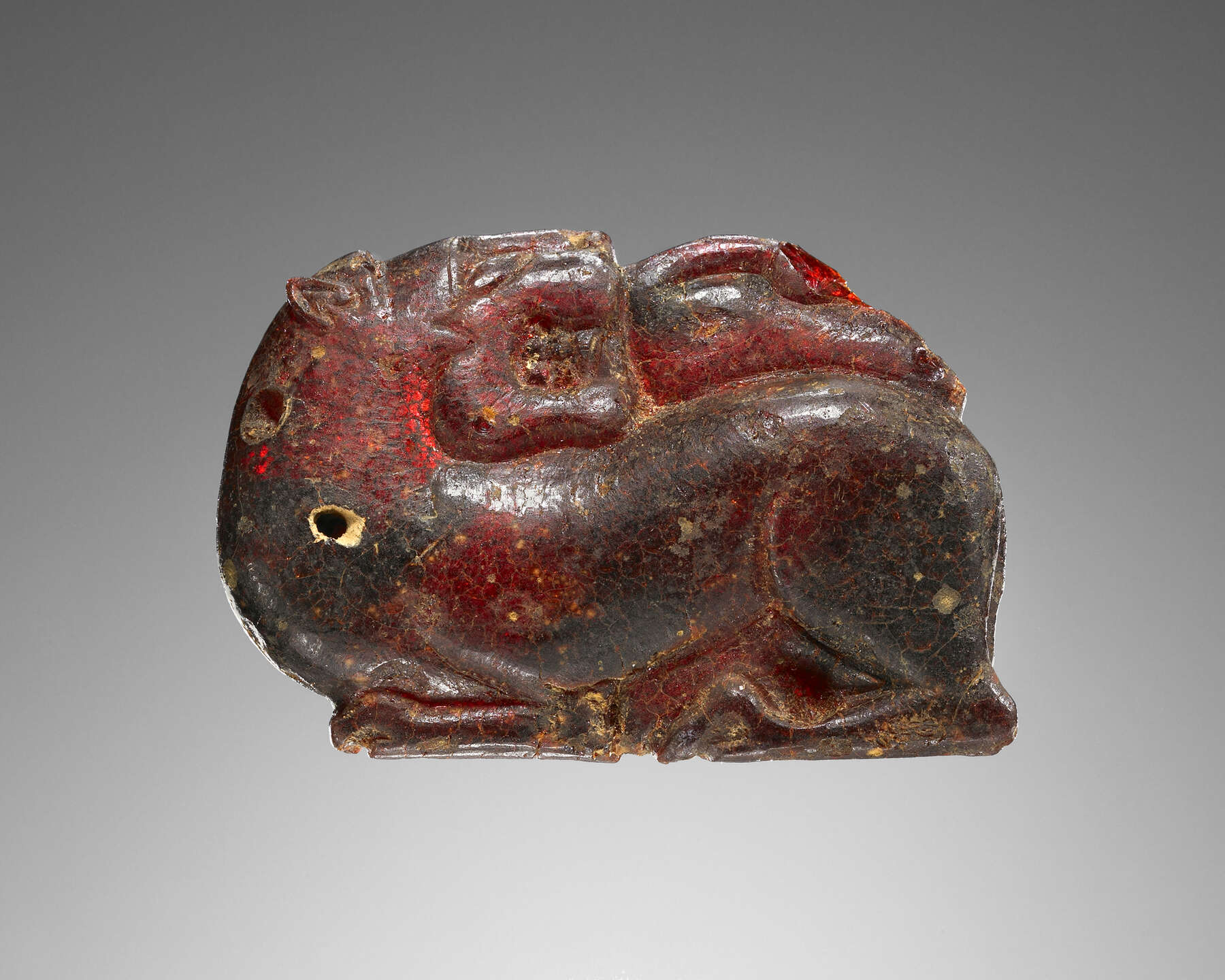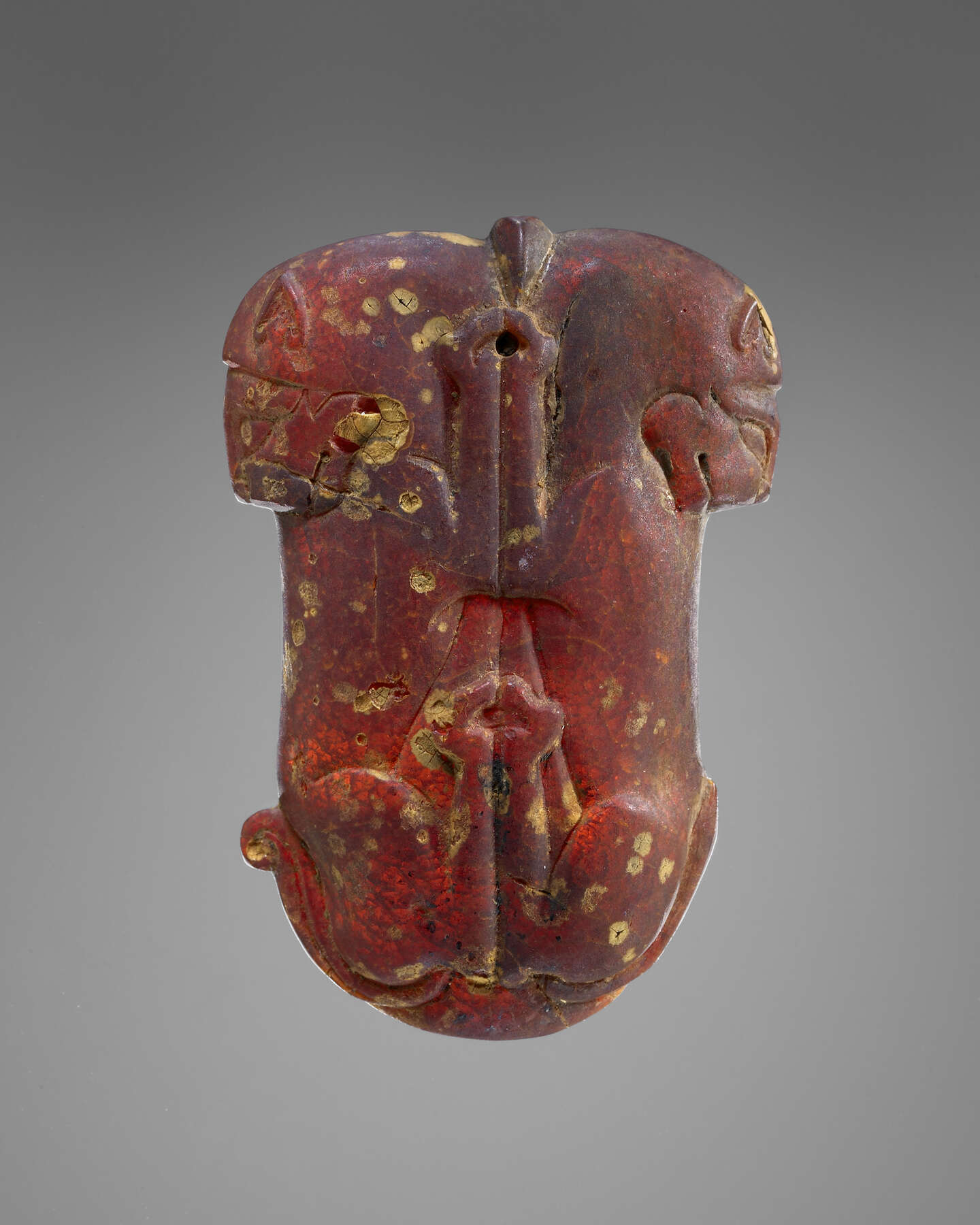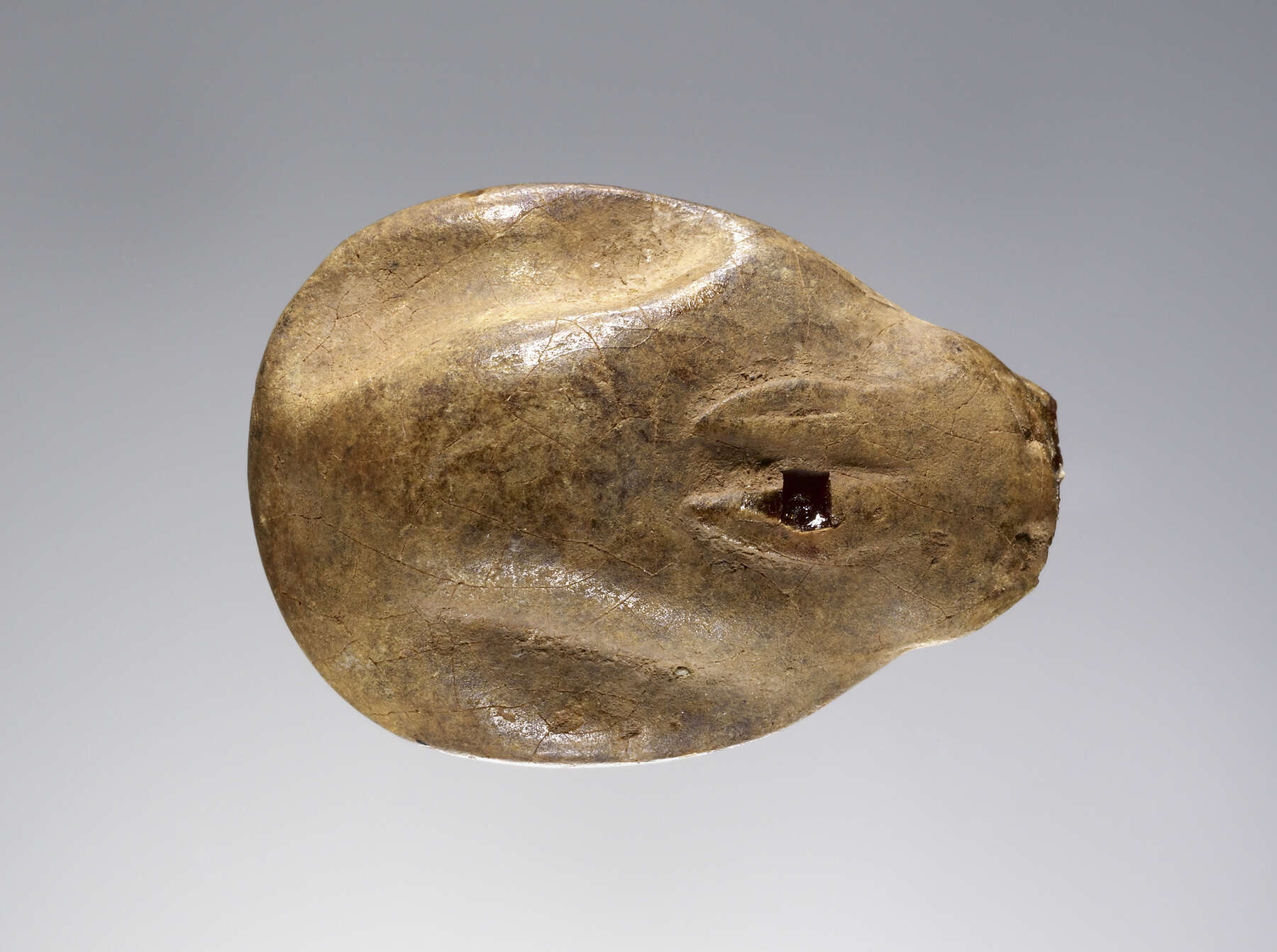4. Pendant: Divinity Holding Hares
| Accession Number | 77.AO.82 |
| Culture | Etruscan |
| Date | 600–550 B.C. |
| Dimensions | Height: 97 mm; width: 64 mm; depth: 24 mm; Diameter of suspension holes: 2.5 mm; Weight: 76 g |
| Subjects | Artemis; Childbirth; Egypt; Etruscan culture; Hare; Ionia, Greece (also Ionian, Greek); Magic; Potnia Theron |
Provenance
–1977, Gordon McLendon (Dallas, TX), donated to the J. Paul Getty Museum, 1977.
Condition
The piece is in excellent condition, and its surface is uniformly hard, smooth, and shiny. The amber is crazed overall and has numerous minute cracks and fissures, which are especially noticeable on the figure’s feet and in the head and body of the hare to her left. The broken tip of the left hare’s nose is the only significant loss to the pendant. In ambient light, the piece is dark red-orange and translucent; in transmitted light, the amber is transparent and bright red-orange. There is a large, cloudy inclusion in the upper body of the hare on the figure’s right side, and other inclusions are scattered throughout the piece.
Description
The pendant is worked from a large piece of amber, rounded on both the obverse and reverse sides. The figure is identified as youthful because of the lack of beard hair and the relative body proportions. Its sex is not evident.
The figure wears a short, simple, schematically rendered short chiton, or chitoniskos. There is no indication of the front neckline or the sleeve hems, and no belt. The top edge of the footwear is not indicated, but the smooth, close-fitting shape and pointed toe box suggest that they are boots. The figure stands in a rigid frontal pose. In each arm, the figure grasps the hind feet of a large crouching hare held head downward. The space between the figure’s neck and the hares’ bodies is undefined.
The figure’s head is large in proportion to the body; its narrow shoulders slope slightly. The broad chest protrudes in the breast area, but there are no individualized breasts. The hips are narrow. The back is full through the upper area and concave in the lumbar region, and the rounded buttock area protrudes. The long, thin arms end in small, rounded hands. Each hand shows four fingers and the roots of the thumbs. The legs are thick, short, and sturdy, with full thighs and calves, and are contiguous for their full length. No knees are indicated. The feet are small.
Geometry and pattern infuse the face: it is round, broad, and flat; the curve of the hairline in front is echoed by that of the eyebrow ridge, and the line of the lower eyelids mirrors that of the chin. The eyes are blank, elongated ovals that are plastically rendered and outlined with raised eyelid rims. The outer canthi are higher than the inner ones, and the left eye is narrower and slanted farther upward than the right. Both the frontal and parietal eminences of the cranium are wide. The otherwise flat forehead bulges slightly at the brow ridge, but there is no indentation for the root of the long nose, which lies at an angle close to the face. The upper lip area is short, the mouth small, and the mentolabial sulcus shallow. The mouth is wider than the nose, the lower lip wider than the upper. Grooves indicating the mouth furrow run from the top of the nose wings to the corners of the mouth. The lips, formed by two nearly parallel bars separated by a groove, have their corners punctuated by drilled indentations. The chin is also wide and projects slightly, the under-chin area full and angled downward to the neck. In front, the smooth cap of hair is raised above the plane of the brow; in back, the hair follows the shape of the skull and is wide through the crown and indented below the occipital protuberance. A point of hair at the neck extends below the juncture with the spine (in the cervical region) and must overlap the neckline of the tunic in back.
The hares are large compared to the human figure and are powerfully built, with compact, muscular shoulders and legs. Their forelegs are stretched out under their chins, and the hind legs are tucked up close under the bodies. On each animal, an incision line separates the front of the face from the back of the head. The hares’ ears are long and pointed and lie flat against their shoulders. Their longish tails hang down their backsides, with the tip of each tail touching the head of the human figure, creating a parallel line across the top of the pendant.
There are abrasion and scraping marks in many places on the pendant. Drill holes define the indentation between the toes and footpads of the hares’ feet and punctuate the corners of the figure’s mouth, the corners of the hares’ mouths, and the roots of the hares’ ears.
The pendant is drilled for suspension with two long perforations, both of which exit at the top, in the crown of the figure’s head. The perforations’ lower ends exit on the reverse: one hole is between the foot of one hare and just below the figure’s left ear, and the other is in the crook of the hare’s foot near the figure’s right elbow. The least visible and perhaps the strongest method of suspending the pendant would have required two filaments, each tied in a knot at the lower end of the reverse exit holes, the two meeting at the top hole and knotted at this juncture.
Discussion
Although it is comparable in style, technique, and sculptural conception to the other five pendants in the Getty Orientalizing group— (cat. no. 1), (cat. no. 2), (cat. no. 3), (cat. no. 5), and (cat. no. 6)—there are no close parallels for this pendant in any media. All six of these pendants demonstrate stylistic and iconographic connections with Near Eastern, Peloponnesian, South Ionian, Cypriot, and native Italian sculpted objects in bronze, ivory, terracotta, and amber. Like those of the other five, the composition of 77.AO.82 is of an ancient type and shows well the broad range of visual schemata, techniques, and styles current in northern inland Etruria.
No definite conclusion has been reached about the sex or age of the figure. As to identity, the composition, the age-old “Mistress” or “Master of the Animals” schema, announces that the figure is heroic or divine (or both). The proportions, head-to-body and legs-to-torso, the short neck, high chest, and small feet, and the relative scale of hares and figure seem to suggest that the figure is that of a child, but there exist many images of adults with these characteristics in Greek and Etruscan art of this and earlier periods.
The somatic parallels with some images of children in Hittite art are striking. A critical comparison is the rock-crystal figure of a child in the Walters Art Museum, which Jeanny Vorys Canby demonstrates to be a “Hittite expression of the miraculous child concept.”1 The short hairstyle, head-to-body proportions, and general sculptural form are remarkably alike.
Neither the hairstyle nor the dress of 77.AO.82 indicates with certainty the sex or age of the central figure. The hair is short and somewhat similar to what Emeline Richardson calls the Etruscan Ducktail, the masculine chin-length cut worn by Early Etruscan votive bronzes of elite males, swordsmen, spearmen, and kouroi.2 It is not far from the fashion of the sacrificing youth of the Campana Panel, which Sybille Haynes interprets as hair shorn in mourning.3 The amber figure’s hair can be compared to certain images of Artemis, but it has no analogue. A bronze statuette of Artemis (or an adorant or juvenile dedicant) from Lusoi has hair that is cut short in back and with short bangs, a boxy hairdo. This bronze dates to the end of the sixth century B.C. and is thought to be a variant of a cult statue of Artemis Hemera, goddess of Lusoi. It conserves much older traits.4 Overall, it is the object most similar to 77.AO.82 in hairstyle, dress, and blocklike body. Parallels for the hair may also be drawn with some ivories of Artemis Orthia from her Spartan sanctuary. In these, the divinity is young and has cropped hair; in some cases she wears a feather headdress.5 These Spartan figures wear a long, smooth-fitting dress that contrasts with the shorter one worn by 77.AO.82 and the shorter chitons of the Lusoi bronzes. The Spartan ivories belong to what may be the oldest type of Artemis representations, that of the goddess in the form of a frontal draped standing figure.6
The amber figure’s costume—the plain, short dress and boots (or bare feet)—is not unusual for male figures, such as hunters, archers, shepherds, charioteers, riders, athletes, and flying figures, but it is uncommon for females. An important comparison is one of a pair of seventh-century B.C. female stone figures from Casale Marittimo (Volterra). Figure A wears a long braid and a perizoma over a short tunic (and her disproportionately long arms and hands are held across her chest in the “mourning gesture”).7 Later Campanian and Etruscan bronze archers (of circa 530–500 B.C.) wear leggings under a very similar short costume, but many of the latter are not clearly sexed; they are often also called Scythians and Amazons.8 Early Etruscan masculine parallels for the clothing of 77.AO.82 are the tunics worn by three bucchero athletes (who also wear the perizoma) and at least one of the hunters on the Bernardini sheath,9 as well as by the riders on the terracotta relief plaques from the principal building at Poggio Civitate.10 Later sixth-century B.C. examples are two of the male subjects of the antefixes from the Temple B cell-row building at Pyrgi, the winged and rayed sun-god Usil and a bird-headed figure, who is probably Lucifer, the morning star.11 Important Greek masculine parallels for the amber’s dress (and for its iconography) are the sixth-century Arcadian and Sicyonian bronzes representing Hermes Kriophoros and other unnamed shepherds,12 certain Ionian bronzes of active figures,13 and an ivory figure of a horse-tamer from Vathy, Samos.14 All these works present the short garment as a close-fitting, smoothly rendered sheath of thick cloth.
Among the Greek female parallels for the short chiton are various active figures, athletes and hunters most notably. As Eva Parisinou outlines, the short hunting dress is worn not only by Artemis, but also by the hunters Atalante and Prokris, by the hunting female demons the Gorgons and the Erinyes, and by female athletes.15 The short garment may denote the status of the figure and its activity; the same was true for girls who wore the exomis at the Olympian Heraia.16 One of the earliest antecedents for 77.AO.82—if it is female—is a unique and early Greek bronze of an armed female from Thermon, variously dated between the twelfth and eighth centuries.17 She wears a short chiton, necklace, and boots, and carries a bow in her right hand. Her hair is gathered up under a pointed hat. This may be the same subject as a bronze of a running “girl” from Samos of about 600 B.C.18 Etruscan parallels for the chiton of 77.AO.82 include those of the figure (Thesan/Dawn) controlling winged horses who decorates another of the six astronomical antefix types from the south side of Temple B of Uni/Astarte at Pyrgi;19 the bird-grasping divinity represented on a series of Etruscan terracotta antefixes from Capua;20 and a bronze found at Pietrabbondante. The bird-tamer’s chiton is longer than the hare-tamer’s, but it is similarly rendered—simple in its line, it suggests easy movement. (The Capuan figures and the amber hare-tamer are also comparable in their general proportions, youthfulness, face shape, short neck, and long, thin arms.) The bronze from the Pietrabbondante sanctuary wears a shortened dress, and her short hair forms a point in back.
The Ionian aspects of the amber hare-tamer’s style are brought out by comparison not only to the Samian bronze of the running girl and to the Ionian-looking Peleus from the Loeb Stand C,21 but particularly to the ivory horse-tamer in Vathy. This last and 77.AO.82 also share iconography (both figures have short hair and wear unbelted chitons and smooth-fitting boots) and a similar technique (low relief, smooth modeling, and an analogous use of graving tools).
Seven other Etruscan sculptural comparisons, all strongly Ionian in style, are related to 77.AO.82, not only in artisanal terms, but also in iconography. They are a large terracotta votive statuette from Portonaccio, Veii,22 and four related bronze works: the “Herakles” from Valle Fuino (Cascia) in the Vatican, a bronze in Geneva (Musée d’Art et d’Histoire MF 1017), one in the Louvre, and another in the Getty Museum (96.AC.124).23 All these figures are distinguished by tall, pointed headdresses or hats that curve forward and animal skins, which in most cases are arranged so the head hangs in front of the pubic area, in sporranlike fashion. Massimo Pallottino suggested that the Portonaccio terracotta represented an unnamed divinity of the Etruscan pantheon, and Giovanni Colonna convincingly associated it with the cult of Aritimi in the sanctuary at Veii.24
In answer to the question of who is represented in 77.AO.82, two depictions of masculine figures with hares are important. The winged and snake-tailed male demon of an Etruscan repoussé relief, dated to 600–585 B.C., holds a hare and a lotus flower in his left hand and a wader in his right.25 A sixth-century B.C. haruspex on a gold ring, who holds a hare in the left hand, is a valuable testimony to the sacrifice of the hare in Etruscan haruspicy. The figure on the ring, probably from Vulci, was once identified by Rodolfo Siviero as Artemis.26
The composition of 77.AO.82 is also eloquent in establishing the perimeters of the identity. The image of a contest between a human figure and animals is known in Mesopotamian art since the fourth millennium and is generally interpreted as a symbol of power or control over nature, and possibly also as a symbol of protection.27 While both male and female protagonists are known in the art of the Minoan-Mycenaean world, the female is more common. Images of the female figure with animals, first named Potnia on Linear B tablets, seem to have incorporated the Mesopotamian ideology relating to this composition. In Greek Olympian religion, this Mistress of the Animals disappeared, and her role and divine attributes were incorporated by other goddesses, among them Athena, Rhea, Hera, and Artemis. In Italy, there appears to have been incorporation by some unnamed divinities. By the seventh century B.C. in Greece and in Italy, the “mastery of the animals” schema was adapted to fit current needs, with variants sometimes differing significantly from the Oriental prototypes. Nevertheless, some elements remain constant, chief among them the symmetrical scheme, the frontality of the female figure, and the animals. Although in Italy, images of a “mistress” are more frequent than those of a “master,” both subjects are found in Etruscan art. The “master” is usually shown between horses, and the “mistress” is shown as overcoming lions, most commonly, and birds (raptors and waterbirds, especially geese and swans).
While some scholars believe that the mastery imagery came directly from the Orient to central Italy, others have proposed that the subject was transformed in the Mediterranean East before its adoption on the Italian peninsula. There was direct contact with Cretan material in some instances.
Homer calls Artemis Potnia Theron (mistress of the wild beasts) in the Iliad (21.470). I. Krauskopf has argued that the Potnia Theron known in Etruria from the seventh century onward is more like a demon than a divinity proper (such as Artemis) and that there was no early connection between Artemis and Potnia Theron, since in Etruria the latter is never represented with Artemis’s favorite animals. Noting that there is no identifiable Artemis (Artumes) in Etruria before the second half of the sixth century, she suggests that if there is a blending of the two, it is perhaps under Greek influence.28 H. Damgaard Andersen suggests that the Potnia Theron figure of central Italy must be considered a local goddess and her cult a nature-worshipping one.29 She proposes that the goddess’s iconography changed in the Orientalizing period from the primitive Iron Age figure into one more like Near Eastern forms under the influence of luxury objects brought to Italy by Phoenician merchants and traders, “who in this way might have initiated an important development of the Italic religious beliefs or at least of the iconography of these deities.”30 Further, she argues that the importance of Potnia Theron diminished by the second half of the sixth century, since images of the goddess became scarce except in bucchero, and proposes that throughout the seventh and sixth centuries, as the Etruscan pantheon was slowly established, strongly influenced by the Greek, the old Potnia Theron seems to have been subsumed, possibly into aspects of more than one deity but including Ishtar/Astarte or Uni, Artemis/Artumes, or perhaps Vei/Ceres.
What Sybille Haynes sagely comments about Etruscan Orientalizing nude females of ivory and gold is relevant for female divinities of the period more generally: “It is possible that these images corresponded to preexisting concepts of nature divinities flanked by birds and quadrupeds that figured in earlier representations on open-worked bronze handles found as far apart as Bisenzio, Bologna, and Spadarolo.”31
The hares, too, are critical to the identity of 77.AO.82. They bear a strong stylistic similarity to the lions of the group— and —especially in the detail of the line separating the faces from the upper part of the head, and to the comparisons presented for them in the catalogue entries below. Both in style and in subject, they relate to the pairs of lions held by Potnia Theron figures molded on the handles of a series of bucchero kyathoi from Chiusi and Poggio Civitate.32 (See and for further discussion.)
Hares are an uncommon subject of jewelry and amulets in the art of Greece and ancient Italy, but they are much more commonly represented in vase painting of the seventh and sixth centuries. The few early examples of the hare as a subject of an Etruscan object of adornment (amulet, pendant, or ring) stand out. One is a tiny ivory pendant-amulet from Murlo, which this author identifies as a curled-up, couchant hare. Another is a carved carnelian with a crouching hare.33
The hares of 77.AO.82 are not newborns but large, mature animals. Wild hares, such as the indigenous Italian Lepus corsicanus and the Lepus europaeus, may grow to 75 cm in length.34 (It should be noted that the females of the Italian hare are larger than the males of the species.) “When going it springs,” says Xenophon of the hare. “No one has ever seen or will ever see a hare walking.”35 Hares possess excellent senses of sight, smell, and hearing; they were the fastest of the wild animals of ancient Italy; and they can dodge and change direction quickly or dive into streams if needed, as they are able swimmers.36
A successful chase would no doubt attest to the hunter’s great fleetness of foot, command of the coursers, perhaps, and success with the throwing stick. Catching a hare might also be the result of a good snare. The hares of 77.AO.82 are in a crouching pose, alert yet carried head downward and encircled in the arms of the smaller figure, emphasizing the power of the hunter.
The wide-open eyes of the hares may specifically allude to the ancient belief that the animal slept with its eyes open and was thus always vigilant. Since the hare is also a burrower, a creature that moves between the earth and the subterranean realm, it had, like the snake, chthonic associations.
Hares rarely accompany figures in the mastery pose. Lions are the most common subject, long-necked waterfowl (especially waders) the second most common, and horses the third. There appears to be but one extant example of a hare-grasping female divinity: the main subject of the handle of a Laconian mid-sixth-century bronze hydria found at Grächwil, Switzerland.37 The figure, called by some scholars Artemis and by others Potnia Theron, stands atop lions and bearded snakes and holds a pair of live hares firmly in her hands, one head upward and the other head downward. A raptor is perched atop her crown.
In some societies today, birds and hares are among the first wild prey children learn to hunt, chase, or trap.38 Of course, hare hunting was not limited to the young in the ancient world; Xenophon’s Cynegiticus, for instance, is especially concerned with chasing hares. As an animal of the wild, the hare belonged to the deities of the hunt. Xenophon recommends that a hound be loosed on a hare only after a vow has been registered to Apollo and Artemis the Hunter, and that hunters dedicate newborn hares to Artemis.39 Not only did Artemis watch over the newborn, as noted earlier; she also protected the unborn.40 Callimachus, writing in the third century B.C. and drawing on a wealth of ancient tradition, claims that Artemis’s main pursuits are “the bow and the shooting of hares and the spacious dance and sport upon the mountains.”41 Callimachus also refers to Artemis as Chitone, and his Artemis asks Zeus to “give me to gird me a tunic with embroidered border reaching to the knee, that I may slay wild beasts.”42
If the hare-tamer of 77.AO.82 does represent Artemis, or a related female divinity, the emphasis is on her aspect as young virgin goddess of the hunt, a double-edged role: as a fertility deity, she ensures the hunt and the well-being, safety, and reproduction of wild fauna, but as a hunter herself, she is lethal.43 If the amber represents Potnia Theron, the hares may underline her chthonic aspect.44 The Grächwil hydria handle may exemplify this. The fauna around the divinity represent her broad influence: she controls the earth dwellers, the lions; those who live both above and below the earth, the hares and snakes; and the hunter in the sky, the raptor—whose prey can be all creatures of the underground, the earth, and the sky. The hares and snakes reiterate the connection of the divinity with the realm below.
Hunting itself connects two realms, the outside, the wild, the nonlocal, and the unfamiliar with the inside, the domestic, the local, and the familiar, as Mary Helms suggests.45 Hunters are often seen as shamans who mediate between these two worlds and have the uncommon ability to participate in unknown worlds.46
In Egypt, the hare was the sacred animal of Wenet, an anthropomorphic goddess who wore a standard on her head with a recumbent hare. According to Plutarch, the Egyptians esteemed the hare as a symbol of divine qualities, because of its swiftness and acute senses. The relation of the hare to Osiris, which has been variously affirmed, is unexplained but may have to do with the animal’s burrowing. In Greece, the hare is linked with other female and male divinities as well. One of the earliest marble korai, a headless figure from Samos (Berlin, Staatliche Museen 1750), holds a young hare.47 Previously interpreted as an offerant to Aphrodite, it has now been associated with Hera. Another Samian statuette of a kore holding a hare, a recent find, has also been considered a votive gift to Hera.48 A marble kore consecrated in the Milesian sanctuary of Artemis Kithone/Chitone holds a bird in her hand; Katerina Karakasi interprets this kore as venerating Artemis not only as a fertility and vegetation goddess, but also as the goddess of the hunt.49
If the amber tamer is male, the hares may indicate a hunter-tamer, and Artemis’s brother may be called up. Dionysos, too, is associated with the hare: youths carry dead hares in the company of the god; on two vases of the Amasis Painter, women (maenads) bring live hares to Dionysos; and on a vase by Lydos, a small satyr leans down to pet a hare in a scene with Dionysos and his entourage. Is the hare held by a maenad in the presence of Dionysos on the black-figure neck-amphora in Paris (attributed to the Amasis Painter) a gift to the god or an emblem of the wild nature of the god’s followers?50 However, as T. H. Carpenter points out, there does not seem to be a “consistent pattern of use for the hare in early Dionysian scenes.”51
The Etruscan aspects of 77.AO.82 suggest that the subject had particular relevance in Etruria, and more particularly in central, internal Etruria. Might it represent a native Italian divinity such as that represented by the Vatican “Herakles” or the Portonaccio terracotta? Or could it be a rare illustration of one of the indigenous male hero-divinities that became absorbed into the Etruscan Hercle of the fifth century B.C.?
On balance, given the ancient connection between amber and divinities of light, and the iconographic and stylistic connections of 77.AO.82 to the Artemis Orthia ivories, the Laconian Grächwil hydria, the Lusoi bronzes, and the Samian bronze girl, the evidence seems to support a female identity for the figure. The pendant may represent the Greek (Laconian?) Artemis accommodated to a native female hunting divinity, one traditionally represented in the Potnia Theron schema. Whichever hunting divinity is represented, the pendant would offer protection. If Artemis, she would offer special protection for women in childbirth, not just because of her skill in midwifery, but also because she offers death to women for whom the pain of childbirth would be too great.52 In the Iliad, Hera reminds Artemis, “It was against women that Zeus made you a lion, and granted that you might kill whichever ones you choose.”53 This more violent side of Artemis, from as early as the seventh century B.C., fueled apotropaic magic, and medicine.54 In late antiquity, Artemis the bow-bearer was called upon in “aggressive” magic and medicine as quite literally a “pain-killer.”55 So, too, were Apollo and Herakles. In the rituals of death and in the tomb itself, this ornament-amulet would have offered protection of the most powerful sort. Still to be resolved is the possible relationship of this image with the iconography of the Hittite child. Might this figure, too, incorporate something of the miraculous-child concept?
Throughout antiquity, the hare’s proverbial fertility made it a rejuvenating symbol, and it was used in direct magic to ensure regeneration.56 As an ornament, this large, shining amber carving must have made a great impression with its potent imagery; as an amulet, it would have served its owner(s) well in life and death.57 Among the few examples of amber hare pendants is another pendant in the Getty (, cat. no. 30), a “doubled” fertility amulet combining a hare and a cowrie.58 In magical terms, the hares of 77.AO.82 may have mirrored, increased, or focused the fertility and healing aspects of the divinity they refer to, accelerating the speed with which the pendant could ward away danger (a hare’s foot gives the owner the animal’s fleetness of foot) or promote rapid healing.
Notes
- J. V. Canby, “The Child in Hittite Iconography,” in Ancient Anatolia: Aspects of Change and Cultural Development: Essays in Honor of Machteld J. Mellink, ed. J. V. Canby, E. Porada, B. Ridgway, and T. Stech (Madison, WI, 1986), p. 68. ↩
- The Ducktail is described by , p. 34, as “a smooth cap of hair that makes a low arch across the forehead, leaves the ears uncovered, and ends in a point at the top of the shoulders.” She notes that it is worn by the later group of perizoma-clad spearmen and is “a stiff version of the characteristic haircut of the kouroi of the Middle Archaic period, [which] helps to date these figures in the middle or third quarter of the sixth century.” Compare also the hair of the bronze kouroi in Siena (Museo Archeologico Nazionale di Siena 38720: ibid., p. 122, figs. 250–51) and in Volterra (Museo Etrusco Guarnacci 4: ibid., p. 121, figs. 252–53). ↩
- Painted wall panel of a youth before an altar from the Banditaccia Necropolis, Cerveteri (Louvre Cp 6626): , p. 220. ↩
- Frankfurt, Liebieghaus 436: V. Mitsopoulos-Leon, “The Statue of Artemis at Lousoi: Some Thoughts,” in Sculpture from Arcadia and Laconia: Proceedings of an International Conference Held at the American School of Classical Studies at Athens, April 10–14, 1992, ed. O. Palagia and W. Coulson (Oxford, 1993), pp. 33–39, with earlier bibl., including P. Bol, “Die ‘Artemis von Lousoi’: Eine klassische Wiedergabe eines frühgriechischen Kultbildes,” in Kanon: Festschrift Ernst Berger = Beiheft 15 (1988): 76–88; R. Tölle-Kastenbein, Frühklassische Peplosfiguren: Originale (Mainz, 1980), pp. 149–52; and 2 (1984), s.v. “Artemis” (L. Khalil), pp. 633, 738–40, no. 104, pl. 450. ↩
- For the ivory and bone plaques representing feather-crowned goddesses in various actions, see , pp. 9–17, nos. 1–4, fig. 15. On feathered crowns in Etruscan art, see , pp. 69–70, 135–38, 139, 147. ↩
- 2 (1984), s.v. “Artemis” (L. Khalil), pp. 86–98, 631–32, 742–43, with reference to J. Boardman, “Artemis Orthia and Chronology,” Annual of the British School at Athens 58 (1963): 1–17; and . ↩
- On Figure A as a female, see , pp. 219, 226, n. 36. The pair may be mourners but perhaps not ancestors: see F. R. S. Ridgway, “Near-Eastern Influences in Etruscan Art,” in Italy and Cyprus, 1500–450 B.C., ed. L. Bonfante and V. Karageorghis (Nicosia, 2001), p. 354. L. Bonfante refers to A. Maggiani, “Le statue di Casale Marittimo,” in Principi Guerrieri: La necropoli etrusca di Casale Marittimo, ed. A. M. Esposito (Milan, 1999), pp. 33–39; and , pp. 172–76, nos. 126–27. ↩
- See S. Fabing, “Kneeling Archer,” in , pp. 190–93; see also , passim. ↩
- For the chitoniskos, or short tunic, in Etruria, see , pp. 22–23; and , p. 29. For the bucchero athletes who wear a tunic beneath a perizoma, see , pp. 22–23, fig. 35. For the tunic-wearing kneeling hunter on the Bernardini sheath, see , p. 30, n. 23. ↩
- See M. Cool Root, “An Etruscan Horse Race from Poggio Civitate,” 77 (1973): 121–38. ↩
- , pp. 177–78. For the Pyrgi material, see the publications of the site by or ed. by G. Colonna, including Pyrgi: Scavi del santuario etrusco (1969–71) (Rome, 1992); 42–43, suppl. 2 (1988–89); and Pyrgi: Scavi del santuario etrusco (1959–67), 2 vols. (Rome, 1972). See also I. Krauskopf, “Ikonographische Parallelen im Bereich der Götter-und Dämonenbilder,” in , p. 319, nn. 24–25. ↩
- See cat. no. 2, n. 14, for discussion of the relevant bronzes. ↩
- One example is the runner in Samos (see n. 18, below). ↩
- For the ivory horse-tamer (Samos, Vathy Museum), see cat. no. 2, n. 17. The artistic relationship between the horse-tamer and North Syrian art is evidenced by comparison to such a work as the seventh-century B.C. bronze horse cheek piece from Samos representing animal mastery (Samos, Vathy Museum b 149): , pp. 58–62, pl. 53. ↩
- For females wearing a short garment, see E. Parisinou, “The ‘Language’ of the Female Hunting Outfit in Ancient Greece,” in , pp. 55–72; see also T. Scanlon, Eros and Greek Athletics (Oxford, 2002), esp. chaps. 4 and 5, in which he discusses the Olympic Heraia and Brauronia; N. Serwint, “The Female Athletic Costume at the Heraia and Prenuptial Initiation Rites,” 97 (1993): 403–22; W. B. Tyrrell’s review of Scanlon 2002 (see above), Bryn Mawr Classical Review 2002.05.20; and L. Roccos, Ancient Greek Costume, http://www.library.csi.cuny.edu/roccos/greekcostume. ↩
- See Serwint 1993 (in n. 15, above), n. c. ↩
- Athens, National Archaeological Museum 14.494: 2 (1984), s.v. “Artemis” (L. Khalil), p. 633, pl. 450, no. 103a (under “Répresentations incertaines”). ↩
- Samos, Vathy Museum B3. See , p. 170, figs. 133–34. ↩
- For the Pyrgi material, see n. 11, above. ↩
- In the Capuan terracotta antefixes, the deity is between identical large, long-necked birds (the common crane?). Capua, Museo Campano P. 289/90; Rome, Capitoline Museums; and Paris, Louvre MNB 2071: 2 (1984), s.v. “Artemis/Artumes” (I. Krauskopf), p. 777, pl. 580, no. 8. ↩
- . ↩
- G. Colonna, “Note preliminari sui culti del santuario di Portonaccio a Veio,” Scienze dell’Antichità 1 (1987): 429; and M. Pallottino, “Le recenti scoperte nel santuario ‘Dell’Apollo’ a Veio,” Le Arti 2 (1939): 23–24. ↩
- Vatican, Museo Gregoriano Etrusco 12056, from Valle Fuino: C. Cagianelli, “Bronzi a figura umana,” in Monumenti Musei e Gallerie Pontificie, Museo Gregoriano Etrusco: Cataloghi, 5 (Vatican City, 1999), pp. 159–63, no. 15; and , p. 77, n. 89. The Geneva bronze MF 1017: , pp. 361–62 (type xi), fig. 867. The Paris bronze: A. de Ridder, Bronzes antiques du Louvre (Paris, 1913), no. 223; and T. Campanile, “Statuetta di Eracle in bronzo d’arte etrusca,” 2, no. 3 (1923/24): 453–63, figs. 5–8. The Getty Museum bronze (96.AC.124): , p. 130; , p. 126; and S. Haynes in , pp. 156–57, fig. 70. Two related bronzes are the “Herakles” from Contarina (Rovigo) in Adria (Museo Archeologico Nazionale 9996: ; and , suppl. 1 (2009), s.v. “Herakles/Hercle” [S. J. Schwarz], p. 248), and Geneva, Musée d’Art et d’Histoire MF 10117bis: , fig. 7; and , suppl. 1 (2009), s.v. “Herakles/Hercle” (S. J. Schwarz). ↩
- For an outline of the debate, see C. Cagianelli 1999 (in n. 23, above). The many features in common among the Etruscan terracotta, this group of bronzes, and a pair of late Proto-Elamite arsenical copper statuettes representing a striding horned hero or demon deserve consideration. The strider is a well-recognized type “who descended from the mountains bearing the mighty horns of an ibex and protected by the body of a vulture” (H. Pittman in , pp. 46–48, nos. 15a–b). ↩
- Ny Carlsberg Glyptotek 529 (from a chariot): F. Johansen, “Etruskiske bronzerelieffer i Glyptoteket,” Meddelelser fra Ny Carlsberg Glyptotek 36 (1979): 67, fig. 22; and , pp. 291–97, fig. 1 (p. 292) and pl. XXX, 2. ↩
- Naples, Museo Archeologico Nazionale 25081, Feoli Collection: M. Cristofani in , p. 299, no. 183; and , p. 13, pl. 13, no. 15. ↩
- The “mastery of the animals,” the Mistress of the Animals, Potnia Theron, and Artemis are schemata used to represent various related nature divinities. Discussions of Potnia Theron with particular relevance to this study are C. Christou, Potnia theron: Eine Untersuchung über Ursprung, Erscheinungsformen und Wandlungen der Gestalt einer Gottheit (Thessaloniki, 1968); , pp. 39–48; LIMC 2 (1984), s.v. “Artemis” (L. Khalil), pp. 738–40, s.v. “Artemis/Artumes” (I. Krauskopf), pp. 786–87, and s.v. “Potnia” (N. Icard Gianolio), pp. 1021–27; ; E. Nielsen, “Interpreting the Lateral Sima at Poggio Civitate,” in , pp. 64–71; ; Krauskopf 2000 (see n. 11, above), pp. 315–22; A. Barclay, “The Potnia Theron: Adaptation of a Near Eastern Image,” in Potnia: Deities and Religion in the Aegean Bronze Age, ed. R. Laffineur and R. Hägg (Liège, 2001); and N. Winter, “Commerce in Exile: Terracotta Roofing in Etruria, Corfu and Sicily, a Bacchiad Family Enterprise,” Etruscan Studies, vol. 9, article 18 (2002), http://scholarworks.umass.edu/etruscan_studies/v019/iss1/18. The earliest Etruscan examples of the Great Goddess are close to the early Minoan images of animal mastery. One example is the gold pendant from the Aigina Treasure: C. Gates, “Iconography at the Crossroads: The Aigina Treasure,” in Transition: Le monde égéen du Bronze Moyen au Bronze Récent, ed. R. Laffineur (Liège, 1989), pp. 215–25; and R. Higgins, The Aegina Treasure: An Archaeological Mystery (London 1979). ↩
- Krauskopf 1984 (in n. 27, above). ↩
- . ↩
- Ibid. ↩
- , p. 131. ↩
- , pp. 38–40, nos. 22–23, fig. 13, pl. 67; , pp. 417–24. Valentini located the principal workshop for the production of Potnia Theron figures of this type, her Type A, at Chiusi. ↩
- The ivory pendant of “a sleeping animal” identified here as a hare is Poggio Civitate Antiquarium 71–282: , pp. 75–76, fig. 115. For the Etruscan gem, see M. Martelli, “Un sigillo etrusco,” Quaderni Urbinati di cultura classica 38 (1981): 169–72. ↩
- See, for example, the entry by A. Vu on Lepus europaeus: http://animaldiversity.ummz.umich.edu/site/accounts/information/lepus_europaeus.html. For the Lepus corsicanus, see a recent study by M. Pierpaoli et al., “Species Distinction and Evolutionary Relationships of the Italian Hare (Lepus corsicanus) as Described by Mitochondrial DNA Sequencing,” Molecular Ecology 8 (1999): 1805–17. ↩
- Xenophon, Cyn 5.31. See also 6.11–17. For further descriptions of hare hunting among the ancient Greeks and in Italy, see J. K. Anderson, Hunting in the Ancient World (London, 1985); and K. D. White, Country Life in Classical Times (Ithaca, NY, 1977), pp. 119–20, 122. ↩
- , p. 95. ↩
- For the Grächwil hydria, see cat. no. 2, n. 23. That the figure is the handle of a hydria is significant, especially in the context of the gray marble perirrhanterion (circa 660–650 B.C.), a cult object from the Corinthian sanctuary of Poseidon at Isthmia. Its basin is supported by a quartet of Potnia Theron caryatids holding lions by the tail, with large ram protomes flanking the ring support. E. Neilsen recognized this as the same deity represented in the roof tiles in the early workshop building at Poggio Civitate. Winter 2002 (see n. 27, above), p. 229, notes, “The association of Potnia Theron with the water basin and the edges of a roof where water drains from the eaves may be connected to the role of female caryatids as votive water bearers.” Winter differs with ’s theory that the Phoenicians introduced the figure of Potnia Theron into Etruscan Italy from the Near East. Winter sees a different intermediary, at least for the roofs she discusses. The other animal represented on the perirrhanterion, the ram, is important in the context of carved amber pendants, for rams’ heads are the next most numerous subjects after female heads and are frequently found in conjunction with them. ↩
- Because of the Laconian associations of style and iconography in 77.AO.82, a story recounted by Plutarch may be relevant: one day, at Sparta, while youths and boys were exercising inside a colonnade, a hare appeared, and the boys, still naked, ran out and chased it. For the erotic aspects of the hare and the chase, see ; A. Schnapp, Le Chasseur et la cité: Chasse et érotique dans la Grce ancienne (Paris, 1997); and B. Ginge, The Erotic Hare (Odense, 1981). For the association between Aphrodite and the hare, see , p. 30. Plutarch’s telling of the story in regard to the hunting in Sparta may be of greater relevance for 77.AO.82. The discussion by R. De Puma, Etruscan Tomb-Groups: Ancient Pottery and Bronzes in Chicago’s Field Museum of Natural History (Mainz, 1986), pp. 32–33, of Archaic-period East Greek vessels in the form of a dead hare sheds light on more than the perfume vases. ↩
- Xenophon, Cyn. 5.14. Later in the text (5.33), he writes, “Thus the sight of the hare is so pleasing that there is no one who would not forget about whomever [or whatever] he loved once he saw the hare being tracked, found, pursued, and caught.” ↩
- Artemis is angered at the death of a mother hare and her unborn in Aeschylus’s Agamemnon. ↩
- Callimachus, Dian. 2 (Callimachus: Hymns and Epigrams; Lycophron; Aratus, trans. A. W. Mair and G. R. Mair, Loeb Classical Library 129 [London, 1921]). ↩
- Ibid., 11–12. A stock subject in Attic and Proto-Corinthian vase painting is the dog-chasing-hare motif; the dog with prey (often a hare) in its mouth is the subject of a series of Archaic bronze and terracotta figurines in which the dog usually seizes the back legs of the hare (, p. 57). Might this subject relate to the constellation of Orion’s hound pursuing a hare? ↩
- Of particular interest in Etruria are the molded frieze of hounds pursuing hares decorating the raking gutter (sima) of a building in the Archaic Building Complex at Poggio Civitate; the contemporary hare-hunting frieze on the Etrusco-Corinthian “Tragliatella” jug (from a seventh-century B.C. elite woman’s tomb at Cerveteri, Capitoline Museums 358); the inclusion of the hare (without hounds) in the rows of animals on vases, such as the Caeretan amphora in the Getty Museum (71.AE.289), attributed by J. G. Szilágyi to the Etrusco-Corinthian Group of the Scale Amphorae (perhaps by the Le Havre Painter), of circa 630–600 B.C.; and the head decoration of a pair of recumbent hares and a pair of lions worn by the bearded head of the Etrusco-Campanian infundibulum in Copenhagen (Danish National Museum 3284). Might the subject have also had a danger-averting function, as did the Gorgon antefixes and the panther masks decorating the roofs? , p. 120, notes the connection between the Murlo sima and the Tragliatella jug. For the Getty amphora, see R. De Puma in , United States of America, fasc. 31, The J. Paul Getty Museum, Malibu, fasc. 6 (Malibu, 1996), pp. 13–14, no. 10, who identifies the animal as a “dog (hare?).” For the infundibulum in Copenhagen, see H. Sauer, “Ein etruskisches Infundibulum in Kopenhagen,” (1937): cols. 286–308, figs. 1–3, 13–14; , p. 155, fig. 19; B. D’Agostino, “Il mondo periferico della Magna Grecia,” in Popoli e civiltà dell’Italia antica, vol. 2 (Rome, 1974), p. 199; and B. D’Agostino, “Le genti della Campania antica,” in Italia, omnium terrarum alumna: La civiltà degli Enotri, Chone, Ausoni, Sanniti, Lucani, Brettii, Siculi, Elimi, ed. C. Ampolo et al. (Milan, 1989), p. 572, fig. 555. For the Tragliatella jug, see, for example, , p. 449; and J. P. Small, “The Tragliatella Oinochoe,” 93 (1986): 63–69. , pp. 97–99, argues for a less mythic reading than most other recent interpreters do. Running hares were a favorite theme for the rims of Greek mirrors, most of which have been excavated from funerary contexts. ↩
- Christou 1968 (see n. 27, above) underlines the connection between the “Mistress of the Animals” and the underworld. ↩
- ; ; see also Y. Hamilakis, “The Sacred Geography of Hunting,” in Zooarchaeology in Greece: Recent Advances, British School at Athens Studies 9, ed. E. Kotjabopoulou et al. (London, 2003), p. 240, with references to Helms’s work. ↩
- Hamilakis 2003 (see n. 45, above), p. 240, refers to V. Turner, The Forest of Symbols: Aspects of Ndembu Ritual (Ithaca, NY, 1967); and W. E. A. van Beek and P. M. Banga, “The Dogon and Their Trees,” in Bush Base, Forest Farm: Culture, Environment and Development, ed. E. Croll and D. Parkin (London, 1992), pp. 39–56. ↩
- Berlin 1750: , pp. 27–31, n. 87, with extensive bibl. She assumed the kore was consecrated to Aphrodite and notes that two votive gifts of marble hares were brought to the Heraion, as indicated in the sources. See also , p. 16, n. 59, pl. 11, with reference to . ↩
- , p. 17, nn. 64–68, explains, “Hera and Aphrodite at times fulfilled similar functions.… The hare was probably an appropriate votive offering for both deities, for both were seen as protectors of the female sphere and patronesses of conceptions and marriage. Whereas Aphrodite was more the embodiment of sensuality and erotic love, Hera was associated with the family, virginity, and marriage.” ↩
- Ibid., p. 50, citing bibl., considers that the cult ceremonies associated with Artemis Kithone at Miletos can be considered initiation rites and that there was a “marriage market” aspect to the festivities. On Artemis Chitone, see also N. Strawczynski, “Artemis et Thesée sur le skyphos du peintre de Brygos Louvre G 195,” Revue Archéologique 35 (2003): 3–24; , p. 43, n. 23; W. Günther, “‘Vieux et inutilisable’ dans un inventaire inédit de Milet,” in Comptes et inventaires dans la cité grecque, ed. D. Knoepfler and N. Quellet (Geneva and Paris, 1998), pp. 215–37. Compare this to the high number of archaic terracottas of korai identified as Artemis holding hares. ↩
- Paris, Bibliothèque nationale, Cabinet des Médailles 222 (signed by Amasis as potter): , 152.25, 687; , France 7, III H e, pl. 36, 1–7, and pl. 7. ↩
- , p. 52. ↩
- See , pp. 57–61, on the bow-bearing, death-dealing gods. Odysseus (Odyssey 11.171–73) asks his mother in the underworld, “Was it a lingering illness, or did the archer Artemis attack you with her gentle arrows and kill you?” On Artemis’s role in childbirth, see, for example, N. Demand, Birth, Death, and Motherhood in Classical Greece (Baltimore and London, 1994). S. G. Cole, Landscapes, Gender, and Ritual Space: The Ancient Greek Experience (Berkeley, 2004), p. 212, n. 87, notes, “Artemis Eileithyia is more common epigraphically. Artemis Lochia is more common in literary sources.” ↩
- Iliad 21.481. ↩
- See , pp. 136–40 (appendix 4, “The Incarceration of Dread Goddesses”), with references; and . ↩
- On aggressive magic, see , pp. 26–56. On weaponed divinities and talismanic magic, see , pp. 136–40. ↩
- Hares have many other associations and meanings throughout ancient culture, especially in the circum-Mediterranean world, which may bear on this image. In Egypt, the Cape hare was a frequent subject of desert hunting scenes in tombs. By the New Kingdom, the scene of the desert hunt was already an age-old theme, one of many symbolizing regeneration. Amulets in the shape of a hare have a long history in Egypt. The earliest surviving example is dated to the Old Kingdom; they are occasional in the Middle Kingdom, and more common in the Late Dynastic and Ptolemaic periods. Faïence images of hares were deposited in tombs, probably because “the figures had some magical or amuletic significance” (, p. 70). , p. 64, summarizes: “The hare was credited with powers of regeneration, but its swiftness of movement and the keenness of its senses were also well known: it was even believed to sleep with its eyes open. Its fecundity, of course, was proverbial. Thus a hare amulet could have worked in life to endow its wearer with fertility or rapidity of movement, or in death with hope of rebirth.” Erwin R. Goodenough, Jewish Symbols in the Greco-Roman Period, vol. 8 (New York, 1958), p. 93, sees remarkable persistence in the type and use of hare imagery from the Egyptian, Hittite, and Greek past through Judaism and early Christianity until the early modern period, suspects it was a generally popular symbol of immortality, and believes “[it] represented Dionysus and all other fertility deities through whose destruction and love men came, usually in mysteries, to look for immortality.” ↩
- The hare is a solar symbol in ancient Egypt. This is discussed in M. Caccamo Caltabiano, “Il simbolismo del ‘lepre’: Influenze ideologico-religiose dell’Egitto sull’area dello Stretto riflesse dai documenti monetali,” in L’Egitto in Italia dall’antichità al medioevo: Atti del III Congresso Internazionale Italo-Egiziano, Roma, CNR-Pompeii, 13–19 novembre, 1995, ed. N. Bonacasa et al. (Rome, 1998), pp. 33–45. ↩
- See B. A. Kathman’s entry for the Corinthian “Crouching Hare Toy(?),” in Animals in Ancient Art from the Leo Mildenberg Collection, ed. A. K. Kozloff (Cleveland, 1981), p. 113, no. 94. ↩
Bibliography
- Andrews 1994
- Andrews, C. Amulets of Ancient Egypt. Austin, TX, 1994.
- First Cities 2003
- Aruz, J., ed. Art of the First Cities: The Third Millennium B.C. from the Mediterranean to the Indus. With R. Wallenfels. Exh. cat. New York, 2003.
- Barringer 2001
- Barringer, J. M. The Hunt in Ancient Greece. Baltimore and London, 2001.
- Bartoloni et al. 2000
- Bartoloni, G., et al., eds. Principi etruschi: Tra Mediterraneo ed Europa. Exh. cat. Bologna, 2000.
- Berkin 2003
- Berkin, J. M. The Orientalizing Bucchero from the Lower Building at Poggio Civitate (Murlo). Philadelphia, 2003.
- Bonfante 2003
- Bonfante, L. Etruscan Dress. Updated ed. Baltimore, 2003.
- Bonner 1950
- Bonner, C. Studies in Magical Amulets, Chiefly Graeco-Egyptian. Ann Arbor, 1950.
- Carpenter 1986
- Carpenter, T. H. Dionysian Imagery in Archaic Greek Art: Its Development in Black-Figure Vase Painting. Oxford, 1986.
- Cole 1998
- Cole, S. G. “Domesticating Artemis.” In The Sacred and the Feminine in Ancient Greece, edited by S. Blundell and M. Williamson, pp. 27–44. New York, 1998.
- Cristofani and Martelli 1983
- Cristofani, M., and M. Martelli, eds. L’oro degli Etruschi. Novara, 1983.
- Damgaard Andersen 1996
- Damgaard Andersen, H. “The Origin of Potnia Theron in Central Italy.” In Die Akten des Internationalen Kolloquiums “Interactions in the Iron Age: Phoenicians, Greeks and the Indigenous Peoples of the Western Mediterranean” in Amsterdam am 26. und 27. März 1992, Hamburger Beiträge zur Archäologie 19–20 (Mainz, 1996), pp. 73–113.
- Dawkins 1929
- Dawkins, R. M., ed. The Sanctuary of Artemis Orthia. , supplement 5. London, 1929.
- De Puma and Small 1994
- De Puma, R., and J. P. Small, eds. Murlo and the Etruscans: Art and Society in Ancient Etruria. Madison, WI, 1994.
- Emiliozzi 1997
- Emiliozzi, A., ed. Carri da guerra e principi etruschi. Exh. cat. Viterbo, 1997.
- Faraone 1992
- Faraone, C. A. Talismans and Trojan Horses: Guardian Statues in Ancient Greek Myth and Ritual. New York, 1992.
- Faraone 1991
- Faraone, C. A. “The Agonistic Context of Early Greek Binding Spells.” In Magika Hiera: Ancient Greek Magic and Religion, edited by C. A. Faraone and D. Obbink, pp. 3–32. New York, 1991.
- Freyer-Schauenburg 1974
- Freyer-Schauenburg, B. Bildwerke der archaischen Zeit und des strengen Stils: Samos. Vol. 11. Bonn, 1974.
- Gager 1992
- Gager, J. Curse Tablets and Binding Spells from the Ancient World. New York, 1992.
- Höckmann 1982
- Höckmann, U. Die Bronzen aus dem Fürstengrab von Castel San Mariano bei Perugia: Staatliche Antikensammlungen München, Katalog der Bronzen. Vol. 1. Munich, 1982.
- Haynes 2000
- Haynes, S. Etruscan Civilization: A Cultural History. Los Angeles, 2000.
- Helms 1993
- Helms, M. W. Craft and the Kingly Ideal: Art, Trade, and Power. Austin, TX, 1993.
- Helms 1988
- Helms, M. W. Ulysses’ Sail: An Ethnographic Odyssey of Power, Knowledge, and Geographical Distance. Princeton, 1988.
- Houlihan 1986
- Houlihan, P. F. The Birds of Ancient Egypt. Warminster, 1986.
- Jantzen 1972
- Jantzen, U. Ägyptische und orientalische Bronzen aus dem Heraion von Samos. Vol. 8. Bonn, 1972.
- Karakasi 2003
- Karakasi, K. Archaic Korai. Los Angeles, 2003.
- Kozloff and Mitten 1988
- Kozloff, A. P., and D. G. Mitten, eds. The Gods Delight: The Human Figure in Classical Bronze. Exh. cat. Cleveland, 1988.
- Krauskopf 1998
- Krauskopf, I. “Artemis.” Annali della Fondazione per Museo “Claudio Faina” 5 (1998): 171–206.
- Kyrieleis 1995
- Kyrieleis, H. “Eine neue Kore des Cheramyes.” Antike Plastik 24 (1995): 7–36.
- Langdon 1993
- Langdon, S., ed. From Pasture to Polis: Art in the Age of Homer. Exh. cat. Columbia, MO, 1993.
- Llewellyn-Jones 2002
- Llewellyn-Jones, L., ed. Women’s Dress in the Ancient Greek World. Swansea, 2002.
- Marangou 1969
- Marangou, L. Lakonische Elfenbein- und Beinschnitzereien. Tübingen, 1969.
- Mastrocinque 1991
- Mastrocinque, A. L’ambra e l’Eridano: Studi sulla letteratura e sul commercio dell’ambra in età preromana. Este, 1991.
- Phillips 1993
- Phillips, K. M., Jr. In the Hills of Tuscany: Recent Excavations at the Etruscan Site of Poggio Civitate (Murlo, Siena). Philadelphia, 1993.
- Prayon and Röllig 2000
- Prayon, F., and W. Röllig, eds. Akten des Kolloquiums zum Thema der Orient und Etrurien: Zum Phänomen des “Orientalisierens” im westlichen Mittelmeerraum (10.–6. Jh. v. Chr.), Tübingen, 12.–13. Juni 1997. Pisa, 2000.
- Richardson 1983
- Richardson, E. H. Etruscan Votive Bronzes: Geometric, Orientalizing, Archaic. 2 vols. Mainz am Rhein, 1983.
- Riis 1938
- Riis, P. J. “Some Campanian Types of Heads.” In From the Collections of the Ny Carlsberg Glyptotek,, vol. 2, pp. 140–68. Copenhagen, 1938.
- Riis 1998
- Riis, P. J. Vulcientia Vetustiora: A Study of Archaic Vulcian Bronzes. Copenhagen, 1998.
- Siviero 1959
- Siviero, R. Jewelry and Amber of Italy: A Collection in the National Museum of Naples. New York, 1959.
- Stibbe 2000
- Stibbe, C. The Sons of Hephaistos. Rome, 2000.
- J. Paul Getty Museum 2002
- The J. Paul Getty Museum, Handbook of the Antiquities Collection. Los Angeles, 2002.
- J. Paul Getty Museum 2010
- The J. Paul Getty Museum, Handbook of the Antiquities Collection. Los Angeles, 2010.
- True and Hamma 1994
- True, M., and K. Hamma, eds. A Passion for Antiquities: Ancient Art from the Collection of Barbara and Lawrence Fleischman. Malibu, 1994.
- Valentini 1969
- Valentini, G. “Il motivo della Potnia theron sui vasi di bucchero.” 37 (1969): 413–40.
- Waarsenburg 1995
- Waarsenburg, D. J. The Northwest Necropolis of Satricum: An Iron Age Cemetery in Latium Vetus. Amsterdam, 1995.
